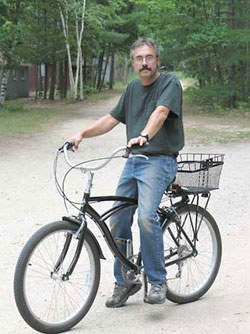A party-line telephone system was cutting-edge technology at the U-M Biological Station near Pellston when Tony Sutterley, now building and facilities senior supervisor, began working there in the ’70s.

The station also looked different. “The exterior of a lot of the cabins were a type of tar paper and they didn’t have attached bathrooms,” says Sutterley, who starts his 30th year at the station this month.
Since then, party lines have been upgraded to high speed Internet connections, and there’s been plenty of remodeling of original cabins and classrooms, and construction of new classrooms, a greenhouse, research building, biotron underground soil lab, two atmospheric research towers, a lecture hall and more year-round housing, to make up the camp’s 110 buildings.
“There’s always something to paint out here,” Sutterley offers, at the 10,000-acre site roughly four hours north of Ann Arbor by auto, on the south shore of Douglas Lake in Munro Township, Cheboygan County. It’s at the northern tip of the Lower Peninsula amidst forests of beech-maple and successional stages of aspen, oak, and pine.
“I first worked at the station the summer of 1976 as a part of the summer staff. I was an apprentice drywall finisher at the time; my family owned a small construction company,” says Sutterley, a Cheboygan native. “But there was not much work in the area and I ended up at the station that summer.”
The next year, the decision was made to hire an assistant superintendent to live on the property. “The superintendent called me and asked me to interview. That fall my wife, daughter and I moved to the station and I’ve been here ever since.”
Sutterley has worked in his present position 16 years, supervising building repairs, grounds, utilities and caring for 25 vehicles that take faculty and students around the station, “and there’s always a special project or two,” he says. “Right now it’s preparing to build another research tower, which will require over a mile of underground power to be brought in.”
Fall means getting ready to close the camp for winter by draining water lines, closing up buildings, doing indoor painting and staining, and building repairs. “We get more than our share of snow up here in the snow belt,” Sutterley says, and staff—which shrinks to two full-time winter staff down from eight in summer—plow roads, shovel roofs, complete indoor building repairs and painting, place supply orders for next year and take care of up to 500 visitors in fall and winter. Sutterley and staff also build leisure chairs and other furniture out of wood for summer use.
The number of visitors, faculty and staff can swell to 280 in summer. When class is over for the day, there’s plenty to do. “Volleyball is big here, people are always playing soccer, and there are a lot of boats on the beach,” Sutterley says. “In evenings people are gathered in small groups by the lake, there’s guitar playing, just about everyone rides bicycles; we’re a walking and biking community.”
Of close encounters with wildlife, “There’ve been no bear incidents,” Sutterley says. He recalls the time a deer crossing a boat channel in winter fell into the water. “We were able to fish it out, we got in the boat and were able to reach down and grab it and got it up into the boat and wrapped it in a blanket in a sunny spot until it got warm and dry.”
Sutterley visits the U-M campus in Ann Arbor once every three years or so, for M-Pathways and P-card training and other duties, and to pick up equipment. “And of course a Michigan/Ohio State game at the Big House,” he says.
Sutterley says what’s best about his job is that his daughters Bianca, 25, and Tennile, 30, who grew up at the Biological station, were exposed to a diverse range of people and experiences. “Growing up in a small town in northern Michigan doesn’t expose you to the diverse group of people I’ve had the opportunity to meet,” Sutterley explains. “I’ve been here long enough to meet someone as a student, see them come back as a grad student, and then come back as an instructor with their family.”
“I’m waiting for the first student to director cycle to happen in my time here.”

